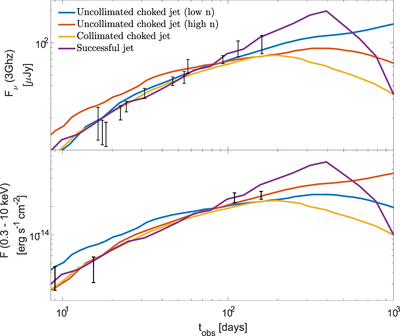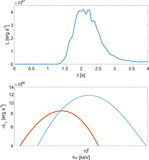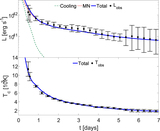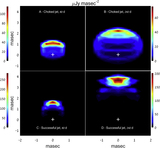Image Details

Caption: Figure 3.
Afterglow emission compared with the radio and X-ray data (Hallinan et al. 2017; Troja et al. 2017; Margutti et al. 2018; Mooley et al. 2018b). Shown are four simulations, two uncollimated, both with a choked jet, and two collimated, one with a choked jet and one with a successful jet. In all simulations the observer is at 0.6 rad (see the Appendix). Both uncollimated choked jet simulations have the same outflow as in Figures 1 and 2. The difference is that one has a high ISM density and a low magnetic field (﹩n={10}^{-2}\,{\mathrm{cm}}^{-3}﹩, ﹩{\epsilon }_{B}=7\times {10}^{-5}﹩) while the other has a lower density and a higher magnetic field (﹩n=2\times {10}^{-4}\,{\mathrm{cm}}^{-3}﹩, ﹩{\epsilon }_{B}=5\times {10}^{-3}﹩). The collimated choked jet afterglow simulation has ﹩n=3\times {10}^{-3}\,{\mathrm{cm}}^{-3}﹩, ﹩{\epsilon }_{B}=3\times {10}^{-3}﹩, and the successful jet simulation has ﹩n={10}^{-2}\,{\mathrm{cm}}^{-3}﹩, ﹩{\epsilon }_{B}=5\times {10}^{-5}﹩. In all simulations ϵe = 0.1 and p = 2.17. All models fit the observations very well, and in all of them the cocoon dominates the emission during most (if not all) of the available observations. The models start to deviate only after about 100 days. In the collimated cases (both choked and successful) the emission near the peak contains a significant contribution from material along the jet axis (in the successful case it is the jet), and following the peak there is a fast decline. The afterglows of uncollimated choked jets also reach a peak, but the following decline is typically shallower than the collimated jets. We note that the jet in the successful case is extremely energetic, with an isotropic equivalent luminosity of 4.4 × 1052 erg s−1, which is unusually high for sGRBs. This is the main reason that its contribution starts so late.
Copyright and Terms & Conditions
© 2018. The American Astronomical Society. All rights reserved.







